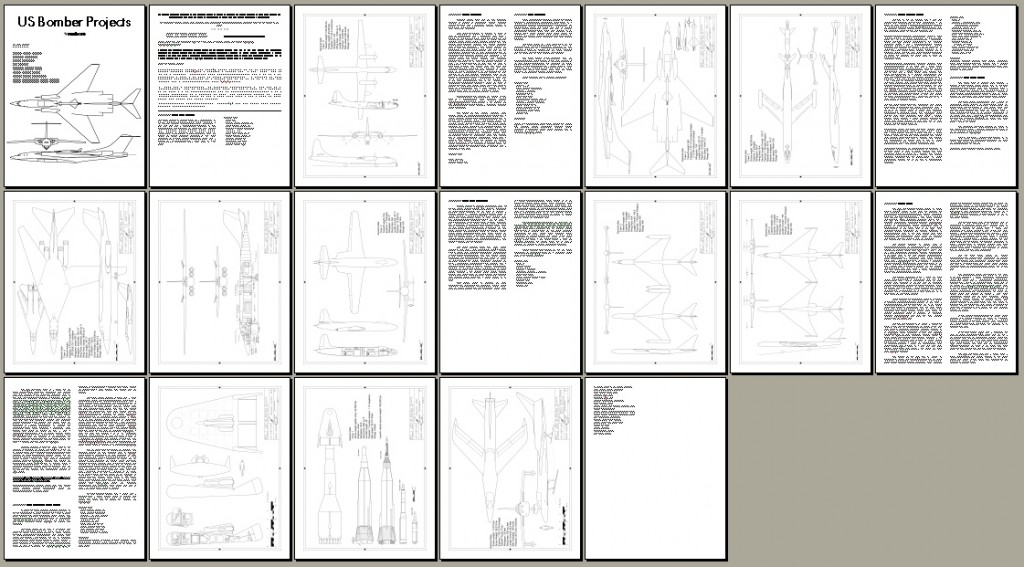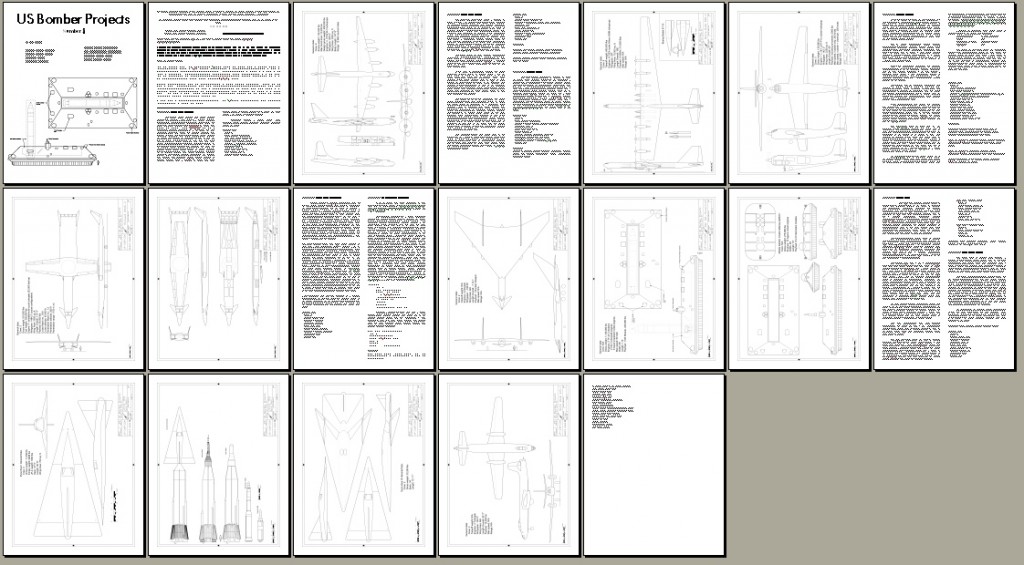A piece of NASA artwork depicting the STAR Clipper, a Lockheed concept for a 1.5 Stage To Orbit space shuttle. Date is uncertain, probably in the 1967-1969 timeframe. Much more on the STAR Clipper can be found in Aerospace Projects Review issue V3N2.
I usually don’t just repost aerospace projects from other websites, but what the heck: An illustration of a 200 megawatt nuclear powerplant for aircraft. This single-reactor, four-turbojet engine would have been installed in a highly modified B-36 or B-60.
This powerplant is very similar to the General Electric powerplant intended for the X-6, which consisted of an R-1 reactor and a P-1 powerplant… four modified General Electric J47 turbojets. However, here the reactor is spherical rather than the R-1’s cylindrical, and the engines are described as Wright engines rather than GE. Wright was not a major designer of turbojets… this drawing might show engines based on the Wright J67, which was a license built version of the British Rolls-Royce Olympus. This nuclear turbojet concept is probably form fairly early in the design process.
The basic concept was simple enough. The reactor would replace chemical jet fuel by putting a heat exchanger where the turbojet would normally have a combustor. In order to get the heat from the reactor to the heat exchanger, a NaK (an alloy of sodium and potassium) would be used. NaK has the convenient feature of being liquid at room temperature (freezing at -11 Celcius), boiling above 785 Celcius. This means that in most conditions, even with the reactor off, the liquid in the pipes won’t freeze, and the liquid will stay a liquid, capable of carrying considerable thermal energy, at usefully high temperatures. On the other hand, NaK has the unfortunate problem of having a serious hatred for water and oxygen, merrily exploding in contact with either (especially at high temperature). If your nuclear engine springs a leak… watch out.
Here are selections from each US Bomber Projects issue released so far, plus one from the next issue (#8). Remember, full issues are only four bucks a pop…
For the next few days blogging might be a bit sparse as I work on the next issues of Aerospace Projects Review and US Bomber Projects. Usually when I release one of these, I get a *few* emails, generally complementary, sometimes asking for clarification or pointing out editing/spelling errors, that sort of thing (and with APR, “make go more faster”). I very rarely get “why don’t you include this” or “why don’t you do that” messages. Well… discuss. What would you like to see new and/or different in APR and/or USBP?
Also: the perpetual problem I have with both of these is lack of public knowledge of these titles. Heck, when I did “The Space Show” interview two months ago, I expected a slight bump in business… but sales (and views of the APR blog) actually went *down* slightly in the week afterwards. Damned if I can figure that out. So if anyone has any suggestions on how to get some press for these little endeavors, I’d appreciate ’em. And of course, an increase in interest & sales will mean an increase on *my* part in producing these things faster, so if you want APR and USBP issues at a faster clip, here’s how to get it done.
Also also: It’s been five months since I submitted my science fiction yarn to Analog magazine. Within 24 hours, their submission website had it listed as “received.” As of a few minutes ago, it was still listed as “received.” Five months seems excessive given that their turnaround time is supposed to be 2-3 months. I can only assume that it has been passed on or ignored (this is, as might be imagined, rather depressing). Anyone have a recommendation for an alternate?
So a year and a half ago, a well-known science fiction author contacted me and wanted to know if I could produce an illustration for a novel he was working on. Why… yes. Yes, I can. And I did. So fast forward to today, and the book (and the illustration) have come out.
Allen Steele’s “V-S Day,” an alternate history of World War II where the Germans produce the “Silverbird” sub-orbital hypersonic rocket bomber, contains two illustrations: my diagram of the Silverbird, and Ron Millers diagram of the US military’s response. Of the two, you can pretty much tell who’s the professional artist…
Anyway, Steele writes good stuff. “V-S Day” is a pretty good yarn. Give it a look!
———–
A North American Aviation concept for a highly modified P-82, dating from 1949. The piston engines would be removed and replaced with Allison XT-38 turboprops. The engines would be located mid-fuselage, necessitating that the cockpit would have to be moved well forward of their normal position. The end result would be a plane that weighed the same, gave the pilots better views and went substantially faster.
This one may show up in a future issue of USBP, as the intended role was ground attack.
From the Jay Miller archive, a 1964 cutaway illustration of the Boeing 733-197 supersonic transport. This was relatively low capacity compared to the later 2707 designs, being somewhat more like Concorde. I’ve seen and scanned several different versions of this, but each has been substantially flawed (this one is gray and the wingtips are out of focus… another is color, but was chopped in half to fit in a proposal, etc.). If anyone might happen to have a high-rez, clear color version, I’d love to see it.
See HERE for more on the 733-197.
Couple being very ill with desperately trying to make a dime, I’ve not had much opportunity to scour my files recently for aerospace projects to blog about. So here’s one: a notion for a fully reusable two-stage-to-orbit launch vehicle produced by North American around 1963. This was part of a study for reusable launchers with a payload of 50 to 100 tons, with the baseline design being a reusable version of the Saturn V.
This design was at the far end of the possible designs, with “nail wings onto S-IC and S-II stages” being on the near-term end. This design would be fully reusable with both stages manned and powered by LOX/LH2 burning expansion-deflection rocket engines. As with many such designs of the time, the wing area is relatively gigantic.
Now available:
Issue number 06 of US Bomber Projects is now available (for background, see HERE). This issue includes:
- Boeing Model 464-18: a reduced-size version of the 464-17 turboprop strategic bomber
- Convair WS-125A: A supersonic seaplane powered by nuclear reactors
- Martin MX-2092: a subsonic jet bomber that towed a large missile
- GD AMPSS: A 1963 variable geometry design leading towards the B-1
- Republic System 464L: a lifting body spaceplane with a nuclear bomb on its back
- Martin Model 223-6: a 1944 step on the road to the XB-48
- Boeing Model 701-273-6: A supersonic bomber composed of two linked aircraft
- Martin Water-Based Attack Aircraft: a single-seat strike plane capable of water takeoffs & landings
USBP#06 can be downloaded as a PDF file for only $4:
——–
———
————————————————-
————————————————-
US Bomber Projects #07 is also now available. This issue includes:
- Boeing Model 464-25: a modification of the 464-17 turboprop bomber with slightly swept wings, among other changes
- Boeing Model 828-2: a giant and incredibly slow long-endurance plane with a formidable payload
- Fairchild N-12: an early nuclear powered turboprop design
- Rockwell D645-3: a supersonic treetop-level bomber capable of completely stowing its wing
- Boeing model 701-273-7: last in the study, a design with a large wing, a small fuselage and canards
- Bell MX-Carrying Hovercraft: a large armored hovercraft complete with an MX missile and self-defense interceptor missiles
- Convair System 464L: Dyna Soar I and Dyna Soar III spaceplanes
- Martin Model 223-7: A 1944 ancestor to the XB-48 with vertically stacked engines
USBP#07 can be downloaded as a PDF file for only $4:
——–
———















